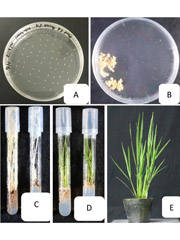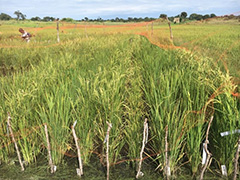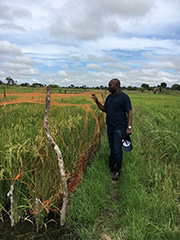Rice Breeding in Zambia Author: Mr. Oscar Malumbe (Zambia Agriculture Research Institute (ZARI)) (2021-07-21)
Mr. Oscar Malumbe who is a MOReDeP full-time counterpart, completed his master's degree at Hokkaido University on a JICA scholarship. He is currently developing rice cultivation technologies. In this article, Mr. Oscar introduces the rice breeding in Zambia
Rice is becoming an important staple crop for Zambia. Demand for the crop has been increasing for the past few years now. In spite of the ever increasing demand for the crop, the current production is not enough to meet demand. According to data of Crop Forecast Survey 2020/2021 (Ministry of Agriculture), rice production is projected to be about 48,000 metric tons. This production is far below the national demand of about 70,000 metric tons per year. The deficit will have to be covered through imports from surplus countries especially Asia. According to the 2nd National Rice Development Strategy (NRDS) 2016-2020, the country's inability to produce rice to self-sufficiency levels have been attributed to a number of challenges facing the rice sub sector such as the ones discussed below:
1. Limited access to improved varieties and quality seed
The majority of the small scale farmers who grow rice do not have access to improved and quality seed. As such, most of them have been using recycled seed of local landraces with a lot of ad-mixtures, resulting in low production, productivity and quality. This problem is due to the fact that the country does not have an active system for the production, multiplication and distribution of rice seed, compared to other crops such as maize, soya and beans.
2. Poor Farming Practices
The traditional cultivation practices (broadcasting seeds, no weeding) used by small-scale farmers fall short of recommended management practices and thus contributes to low production, productivity and quality.
3. Poor Water Management System
With the advent of climate change which brings in the increasing variations in precipitations resulting in frequent occurrence of floods and droughts and other extreme weather conditions, farmers are generally finding it more difficult to manage the water and making it difficult to improve production and productivity.
4. Low level of mechanization
Small scale farmers who are the producers of rice wholly rely on traditional hand tools for land preparation, cultivation, harvesting and processing methods. The lack of mechanization limits the hectarage under rice. This is largely due to none availability or the high cost of mechanized tools locally. This coupled with the poor agronomic practices, largely explains the low production, productivity and quality.
5. Inadequate Human and Institutional Capacity
Identified limitations in human resources and institutional capabilities with regards to research, extension and marketing, which are a consequence of low staffing, funding levels and poor coordination.
Efforts being done to overcome some of the issues highlighted above
In order to address some of the issues affecting rice production as highlighted above, Zambia Agriculture Research Institute (ZARI), working with cooperating partners such as Japan International Development Agency (JICA), have been conducting research on rice in order to develop improved rice varieties and make them available to the small-scale farmers who are the main producers.
With support from JICA, I was sponsored to pursue a master's degree program in plant breeding at Hokkaido University in Japan. At the end of the two year program, the student developed 120 doubled haploid (DH) lines as a result of crossing a local variety with a Japanese variety. In order to shorten the period required to develop a variety, a technique called anther culture was used to produce haploid plantlets which later underwent chromosome doubling using natural methods, resulting in the production of doubled haploid plants. The 120 DH plants were grown and the seed produced was brought to Zambia where it is still undergoing evaluation.

Development of plants via callus culture of F2 genotypes through
anther culture. (A) Anthers on callus induction media, (B) Callus
formation, (C) Albino plantlets regenerated from calli, (D) Green
plantlets regenerated from calli, (E) Anther derived plant growing in green house.
Evaluation of another culture derived doubled haploid plants
The evaluation of the anther culture derived doubled haploid plants is currently going on at Mansa Research Station. The objective of the evaluation is:
・To evaluate the adaptability of the anther culture derived DH lines
・To assess the photoperiod sensitivity of each of the DH lines
・To determine the yield of each of the DH lines
A good number of lines have so far shown good adaptability. Processing of yield and yield component data is still on-going. It is expected that the lines which will perform well will be advanced to the next levels of evaluation and eventually released as varieties. Once released as varieties, farmers will be availed with a wide range of varieties that they can choose from depending on their needs.

DH lines at flowering stage

Checking the progress of the test growing
